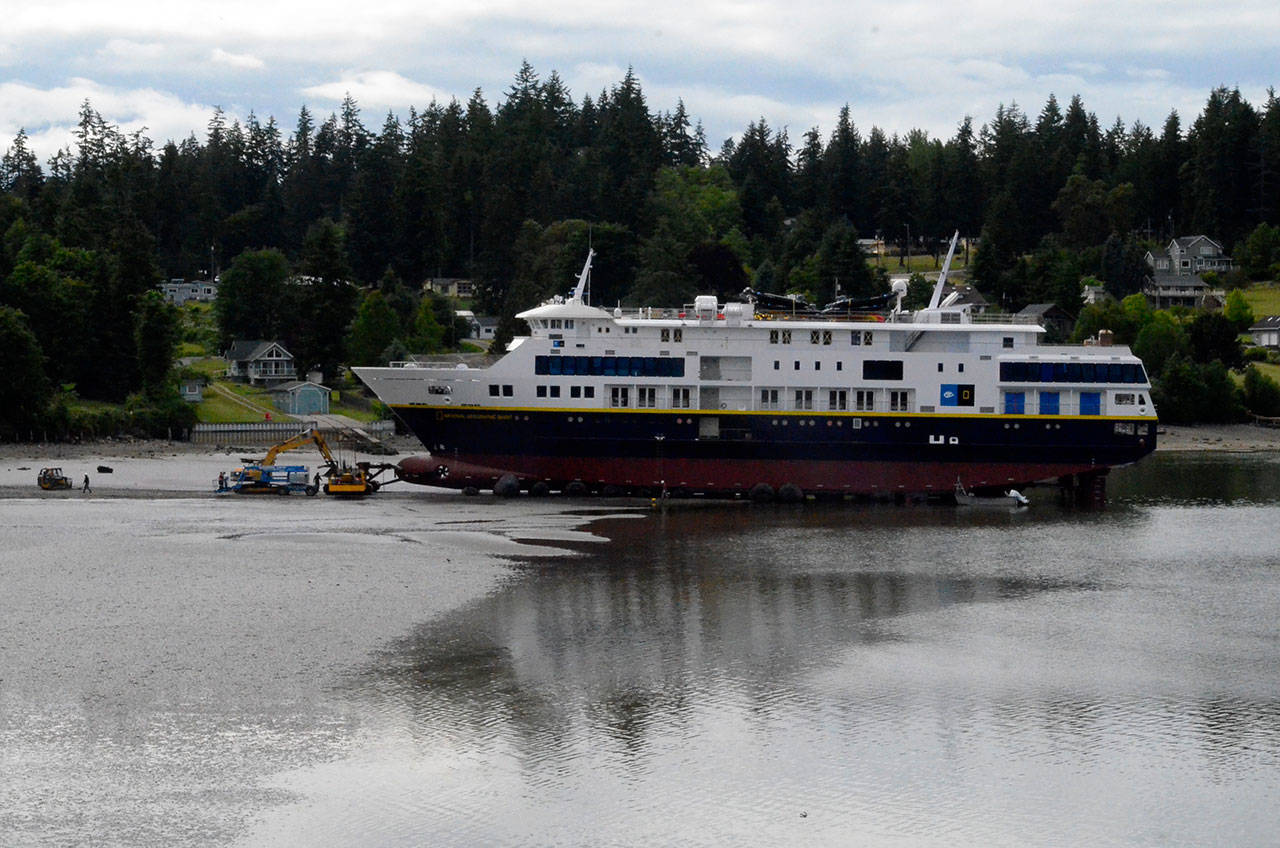Holmes Harbor accepted Nichols Brothers Boat Builders latest contribution to the maritime world this week, a 239-foot cruise ship destined to tour the west coasts of North and Central America.
The $48 million vessel, the National Geographic Quest, was successfully floated Wednesday night following a five-day launch and towed to Anacortes for final outfitting. It’s one of two identical vessels the Freeland shipyard is building for marine-based travel company Lindblad Expedition Holdings, which works in partnership with National Geographic.
The contract for both vessels is $94.8 million.
According to Nichols’ website, the 50-cabin cruise ships can accommodate 100 passengers and will explore Baja, Costa Rica, and Panama during the winter months; and Oregon, Washington, Alaska and Canada during the summer months.
As usual, the launch was something of a spectacle, attracting the interest of the public. Part of the crowd this time, however, included future passengers. Nichols CEO Gavin Higgins said some Holmes Harbor residents have already booked cruises with Lindblad and stopped by the launch for a peek of the Quest.
“They’ve come down looking for their cabins,” Higgins said.
The vessel was designed with a large outdoor sundeck surrounded by a walkway, and will include several dining and entertainment facilities, and a fully equipped fitness and wellness spa.
The Quest is twin screwed — two propellers — with a 3,200 horsepower power plant that will carry the ship at about 12 knots.
The finished vessel will also feature “state-of-the-art expedition technology, including a remotely operated vehicle, video microscope, and a hydrophone and bow-cam designed for immediate bow deployment to hear and film marine life,” according to Nichols’ website.
The launch generated interest from the general public as well as pending passengers. Jeanne Anderson, a Langley resident, said she’d heard about Nichols’ launches since she moved to the island about one year ago and wanted to see one for herself.
She spent several hours camping out on top of the hill on Shoreview Drive on Tuesday afternoon and said she’d planned to spend several more hours there on Wednesday. Looking at the massive vessel resting on the tide flats, she marveled at its size.
“It’s amazing something this big comes out of a little place like this,” Anderson said.
Nichols veered from the track launching system its used in recent years, this time employing more than a dozen inflatable bags to roll the vessel down the ramp and into the water. Higgins said sausage-shaped bags like the ones used this week are common in salvage operations in areas of rough terrain and, in this case, were a good fit for the flat-bottom design of the Quest.
Inflatable bladders can also shoulder the weight of larger ships, he said.
“This system allows us to launch much heavier boats,” he said.
Nichols’ track system is rated for vessels under 1,000 tons — the bags can handle up to 5,000 tons. They also have the added benefit of distributing weight evenly, which minimizes denting to the hull, he said.
“Safety and zero damage” was the goal, Higgins said.
The launch wasn’t without some headaches, however, which stretched the event out to five days, longer than planned. The ship’s descent down the ramp was controlled by a crane and the vessel veered at one point, causing delay. There were other hiccups as well before the Quest was successfully positioned at the bottom of the ramp Wednesday. It was pulled to deeper water by a tugboat later that night, Higgins said.
The section of Shoreview Drive between Cameron Road and Woodard Avenue was closed from Saturday to Thursday. Bob French, the shipyard’s planning director, said the process for closing the road is pretty simple: the company is required to inform the county about the estimated time needed for the closure, and that schedule is then relayed to emergency agencies, such as police and fire districts.
Nichols is also required to pay a fee for each day the road is closed, he said.
Following the Quest’s final outfitting, it will undergo sea trials and stability testing for its certification by the U.S. Coast Guard.
The Quest’s sister ship is scheduled for completion in 2018.



